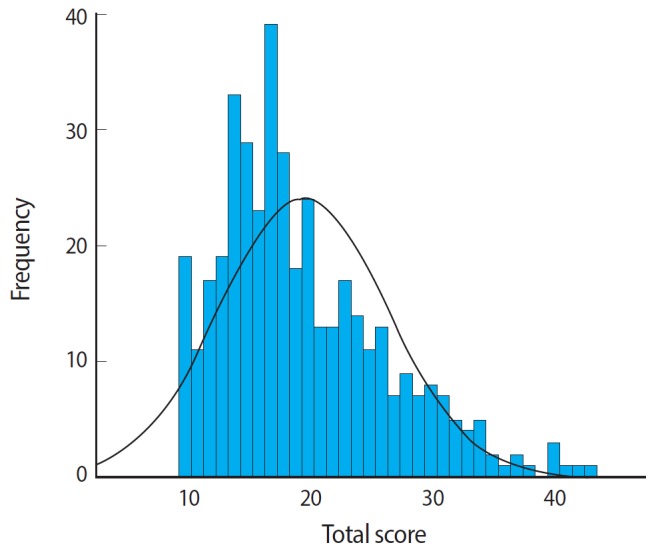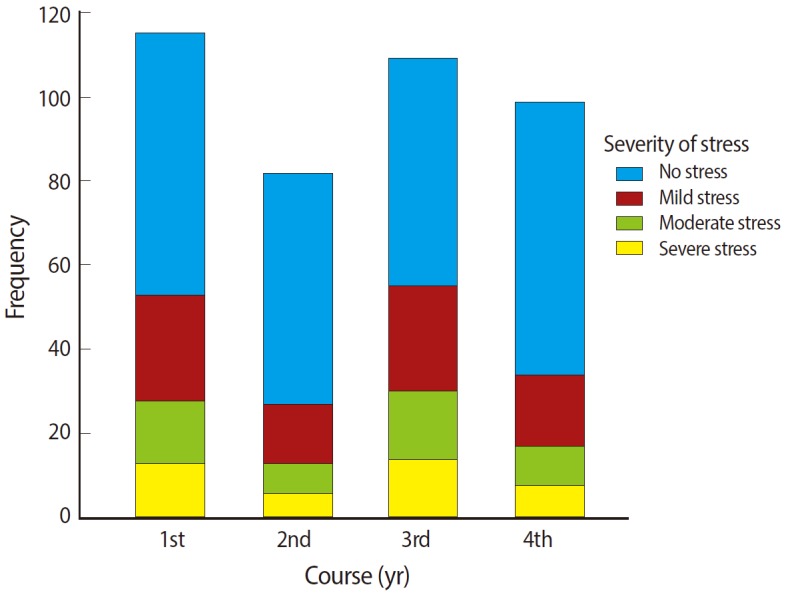Abstract
The aim of this study was to determine the stress level of medical students and the relationship between stress and academic year. A cross-sectional, descriptive study was conducted at an undergraduate medical school with a five-year curriculum, in Pakistan, from January 2014 to April 2014. Medical students in the first four years were included in the study. The Kessler Psychological Distress Scale (K10), a self-administered questionnaire, was distributed to the students. A total of 445 medical students completed the questionnaire. The average stress score was 19.61 (SD=6.76) with a range from 10 to 43. Stress was experienced by 169 students (41.7%). The scores of female students were higher than scores of males, indicating a higher stress level (P=0.011). The relationship between stress and academic year was insignificant (P=0.392).
Keywords: Cross-sectional studies, Medical students, Pakistan, Psychological stress, Questionnaires
Medical students encounter intense and stressful circumstances in the course of their academic studies. This stress may be exacerbated by their educational responsibilities, as well as the overall environment [1]. This study aims to determine the stress level of students enrolled in an army medical school in Pakistan, since the military environment and the maintenance of a focal discipline may produce more stress than in other medical schools. The sex differences in stress levels and the relationship between severity of stress and academic year were also examined.
This cross sectional, descriptive study was carried out from January 2014 to April 2014. Students enrolled in the first four years of the army medical school were included in the study through non-probability consecutive sampling. The study objectives and questionnaire items were clearly explained to the participants, and written informed consent was obtained.
A self-administered, English version of The Kessler Psychological Distress Scale (K10) instrument was distributed to the students [2]. Questionnaires of students who did not provide their consent or those that contained incomplete responses were excluded from the study. The number of potential participants for the study was 800. Out of 445 students who participated, 405 returned completed questionnaires. Each of the ten items was scored on a Likert-type scale from 1 to 5, and scores were summed to provide a total (K10) score. The lowest possible total score was 10 and the highest possible score was 50. Participants’ scores were categorized as follows: 20 to 24 as mild stress, scores of 25 to 29 as moderate stress, and scores of 30 to 50 as severe stress.
Data were analyzed using IBM SPSS ver. 19.0 (IBM Co., Armonk, NY, USA). Descriptive statistics, i.e., mean and SD, were used to provide the results. A t-test was conducted to determine the difference in stress level by sex. A chi-square test was conducted to ascertain the association between stress and academic year.
Out of 405 students, there were 254 males (62.7%) and 151 females (37.3%). One hundred and fifteen students (28.4%) were in their first year, 82 (20.2%) were in the second year, 99 (24.4%) were in the third year, and 109 (26.9%) were in the fourth year. The average stress score was 19.61 (SD=6.76) with a range from 10 to 43 (Fig. 1). Stress was experienced by 169 students (41.7%): 92 males (54.4%) and 77 females (45.5%). Mild stress was experienced by 81 students (47.92%), moderate stress by 47 students (27.81%), and severe stress by 41 students (24.26%). Stress scores for female students (13.0%) were greater than scores for males (11.2%; P=0.011). Most students complained of stress symptoms ‘a little of the time’ during their daily routine. The medical syllabus or course was found to be stressful by the undergraduate medical students, during their first and third academic years, but not in their second and fourth academic years. There was no significant association between stress and academic year (P=0.392) (Fig. 2).
Fig. 1.

Distribution of stress scores for 405 students enrolled in an army medical school in Pakistan, surveyed from January 2014 to April 2014 (mean±SD, 19.61±6.761; N=405).
Fig. 2.

Comparison of stress scores according to academic year for 405 medical students enrolled in an army medical school in Pakistan, surveyed from January 2014 to April 2014.
The above results revealed that students’ stress was more frequent in the first and third year of the undergraduate medical program than in the other academic years; however, there was no significant association between stress levels and the academic year of study participants. The stress factor appears to be more profound during the first academic year. Thus, identifying stress levels during the first year of medical classes and introducing organized strategies to rectify academic-related problems may help undergraduate medical students to overcome stress. Higher stress in female students could be explained by specific psychosocial profiles [1]. Higher levels of stress could harm the psychological health of medical students by affecting their learning and cognitive behavior which ultimately results in inferior patient care. Therefore, there is a need to include stress management education in the curriculum of undergraduate medical students, who experience more stress and depression than the general population does.
Footnotes
No potential conflict of interest relevant to this article was reported.
SUPPLEMENTARY MATERIAL
Audio recording of the abstract.
REFERENCES
- 1.Dahlin M, Joneborg N, Runeson B. Stress and depression among medical students: a cross-sectional study. Med Educ. 2005;39:594–604. doi: 10.1111/j.1365-2929.2005.02176.x. http://dx.doi.org/10.1111/j.1365-2929.2005.02176.x. [DOI] [PubMed] [Google Scholar]
- 2.Kessler RC, Andrews G, Colpe LJ, Hiripi E, Mroczek DK, Normand SL, Walters EE, Zaslavsky AM. Short screening scales to monitor population prevalences and trends in non-specific psychological distress. Psychol Med. 2002;32:959–976. doi: 10.1017/s0033291702006074. http://dx.doi.org/10.1017/s0033291702006074. [DOI] [PubMed] [Google Scholar]
Associated Data
This section collects any data citations, data availability statements, or supplementary materials included in this article.
Supplementary Materials
Audio recording of the abstract.


